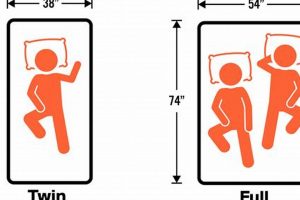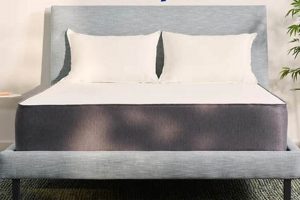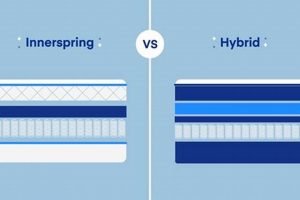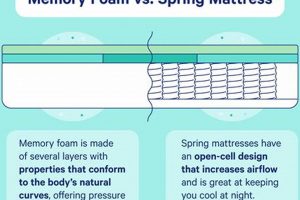The core distinction lies in the uppermost layer of the sleep surface. One offers an additional layer of padding sewn onto the existing mattress, creating a plusher feel. The other presents a consistent firmness across its surface, without an extra layer of padding. An example of the former provides a softer initial contact point, while the latter delivers a more uniform sleeping experience.
This difference in construction impacts several aspects, including pressure relief, support, and temperature regulation. Mattresses with added cushioning may offer enhanced comfort for side sleepers by conforming to body contours. Mattresses without this addition often provide greater spinal alignment for back and stomach sleepers. Historically, the addition of extra padding was intended to mimic the comfort of older, more luxurious mattresses.
The subsequent discussion will delve into a detailed examination of the advantages and disadvantages of each type, specifically regarding their suitability for various sleep positions, budget considerations, and durability over time, assisting readers in making an informed decision.
Considerations for Choosing Between Mattress Types
Selecting the optimal sleep surface requires careful evaluation. The following points offer guidance in determining which design best suits individual needs.
Tip 1: Assess Sleep Position. Side sleepers often benefit from the enhanced pressure relief offered by additional padding, conforming to the shoulder and hip. Back and stomach sleepers frequently find greater support from a flatter surface, promoting spinal alignment.
Tip 2: Evaluate Firmness Preference. Individuals who prefer a soft, enveloping feel may gravitate towards a mattress with an added layer. Those who require a firmer, more supportive surface should consider a standard construction.
Tip 3: Consider Budget Constraints. Mattresses incorporating additional padding may incur a higher initial cost due to the increased materials and manufacturing complexity involved.
Tip 4: Account for Durability Expectations. The extra layer, while providing initial comfort, may compress over time, potentially reducing the lifespan of the mattress. A standard design may offer greater long-term resilience.
Tip 5: Examine Temperature Regulation Needs. Added materials can sometimes restrict airflow, potentially leading to a warmer sleep environment. Individuals prone to overheating should consider options with enhanced breathability.
Tip 6: Investigate Motion Isolation. If sharing a bed, consider how each type minimizes motion transfer. Additional padding can sometimes dampen movement more effectively than a standard design.
Careful deliberation of these factors ensures a more satisfying selection, leading to improved sleep quality and overall well-being.
The subsequent conclusion will summarize the key differences and reiterate the importance of individualized choice.
1. Initial Softness
Initial Softness, in the context of mattress selection, refers to the immediate sensation of plushness or give experienced upon contact. This characteristic is a primary differentiator between constructions, with those that have an added layer of padding generally exhibiting a higher degree of immediate compressibility compared to standard mattresses. The added layer acts as a buffer, yielding readily to pressure. For example, upon lying down on a mattress with extra padding, the body sinks slightly, creating a feeling of being cradled. Conversely, a regular mattress typically offers a firmer initial resistance, providing a sensation of greater support from the outset.
The practical significance of understanding Initial Softness lies in its impact on perceived comfort and suitability for various sleep positions. Side sleepers, for instance, often find that a high degree of initial softness provides relief to pressure points in the shoulders and hips. Back sleepers, however, might prefer the more uniform support offered by a firmer surface, even if it lacks the immediate give of a mattress with extra padding. Therefore, assessing individual sleep preferences and body weight distribution is critical when evaluating the importance of Initial Softness. A mattress that feels excessively soft initially may lack the underlying support necessary to maintain proper spinal alignment over time, leading to discomfort or even pain.
In summary, Initial Softness represents a crucial aspect to consider when comparing these different mattress constructions. While it significantly contributes to perceived comfort upon initial contact, its long-term effects on support and spinal alignment must be carefully evaluated. The ideal level of Initial Softness is highly subjective, dependent on individual sleeping habits and preferences. Challenges arise in balancing the desire for immediate comfort with the need for sustained support, emphasizing the importance of thorough testing and consideration before making a final selection.
2. Spinal Alignment
Maintaining proper Spinal Alignment during sleep is paramount for musculoskeletal health and restorative rest. The design of the sleep surface significantly impacts the ability to achieve and sustain correct posture throughout the night, making the choice between mattresses with and without an added layer of padding a critical consideration.
- Support Layer Consistency
The support layer, irrespective of the surface’s design, must offer consistent resistance to prevent excessive sinking. A support layer lacking integrity can compromise Spinal Alignment, irrespective of the surface padding. For example, an aging innerspring system in either type of mattress can sag, creating an unlevel sleep surface and disrupting the natural curvature of the spine. This underscores the importance of assessing the overall mattress construction, not solely the presence or absence of additional surface padding.
- Surface Contour and Accommodation
A surface with excessive give, as might be found in a thicker, less dense mattress with additional padding, may not provide adequate counter-pressure, potentially leading to Spinal Alignment issues for back and stomach sleepers. In contrast, the firmer surface of a standard design, when appropriately matched to body weight, can offer improved support for these sleep positions. For side sleepers, the ability of a mattress with an added layer of padding to conform to the contours of the hips and shoulders can promote alignment, but only if the underlying support prevents excessive sinking.
- Influence of Sleep Position
Spinal Alignment needs vary based on sleep position. Back sleepers generally require a surface that maintains the natural curvature of the lower back without allowing the hips to sink too deeply. Stomach sleepers need a relatively firm surface to prevent excessive arching of the spine. Side sleepers require adequate contouring to accommodate the shoulders and hips while maintaining a straight line from the head to the tailbone. These positional needs emphasize the importance of aligning mattress characteristics with individual sleep habits.
- Long-Term Impact on Posture
Sustained misalignment of the spine during sleep can contribute to chronic back pain, muscle stiffness, and nerve compression. Selecting a mattress that promotes proper Spinal Alignment, therefore, represents a long-term investment in physical well-being. Regular assessment of mattress performance, and timely replacement when support diminishes, is essential for preventing postural problems. The potential for degradation of the surface material in those mattresses with added padding, leading to uneven support, necessitates a proactive approach to mattress maintenance.
These facets collectively illustrate the complex interplay between mattress design and Spinal Alignment. While mattresses with added layers of padding offer potential benefits for pressure relief and contouring, their impact on Spinal Alignment depends heavily on the quality of the underlying support, the individual’s sleep position, and the long-term durability of the materials. Standard mattresses, with their generally firmer surfaces, offer an alternative approach that can promote alignment for certain sleep positions, provided the support system is appropriately chosen and maintained. A thorough understanding of these factors is essential for making an informed mattress selection that prioritizes Spinal Alignment and overall sleep health.
3. Temperature Regulation
Temperature Regulation, within the context of sleep surfaces, pertains to a mattress’s ability to dissipate heat and maintain a comfortable sleep environment. The design differences between these constructions directly impact their thermal performance. Mattresses with additional padding tend to retain more heat due to reduced airflow, potentially leading to discomfort for sleepers prone to overheating. The increased density of materials in the added layer acts as an insulator, trapping body heat and impeding its dissipation. For example, a sleeper experiencing night sweats may find that a mattress with extra padding exacerbates the issue, leading to restlessness and disturbed sleep. In contrast, standard mattresses, often constructed with fewer layers and more breathable materials, generally offer superior temperature regulation, facilitating better airflow and promoting a cooler sleep experience.
The practical implications of these differences are significant, particularly for individuals residing in warmer climates or those with specific physiological conditions. Sleepers who naturally run hot may benefit from mattresses engineered with enhanced breathability features, such as open-cell foam or specialized cooling fabrics. Furthermore, the type of bedding used in conjunction with the mattress can either mitigate or amplify the effects of temperature retention. For instance, synthetic sheets can further impede airflow, while natural fibers like cotton or linen can enhance breathability and promote a more comfortable sleep climate. Mattress manufacturers are increasingly incorporating advanced materials designed to improve temperature regulation, such as phase-change materials that absorb and release heat as needed.
In summary, the design distinction between mattresses significantly influences their capacity for temperature regulation. Mattresses with added padding generally exhibit reduced airflow, leading to increased heat retention, while standard mattresses tend to offer better breathability. Consideration of individual thermal comfort needs, environmental factors, and the synergistic effects of bedding materials is essential for selecting a sleep surface that promotes optimal sleep quality. Further innovation in materials science and mattress construction will likely continue to address these temperature-related challenges, improving the sleep experience for a wider range of individuals.
4. Long-Term Durability
Long-Term Durability represents a critical factor when evaluating the value proposition. The lifespan of the sleep surface directly correlates to its economic efficiency and overall satisfaction. A mattress lacking robust construction or employing inferior materials may exhibit premature degradation, necessitating replacement and negating potential cost savings achieved through a lower initial purchase price. This is particularly pertinent when differentiating mattress types, where the addition of extra padding can significantly impact longevity.
Mattresses with an integrated surface layer, while offering enhanced initial comfort, are often susceptible to compression and sagging over time. The added materials, typically composed of foam or fiber, experience wear and tear under repeated pressure, resulting in a diminished surface feel and reduced support. For example, a mattress purchased for its plush surface may exhibit noticeable body impressions within a few years, compromising spinal alignment and necessitating replacement. Conversely, regular mattresses, often characterized by a simpler construction and denser support cores, may demonstrate superior resistance to compression and maintain their structural integrity for a longer duration. The absence of an extra padding layer minimizes the potential for surface deformation, contributing to enhanced Long-Term Durability. Routine rotation and the use of a supportive foundation can further extend the lifespan of either type, mitigating wear and preventing premature sagging.
In conclusion, Long-Term Durability serves as a key determinant in the overall value assessment. While mattresses with an added layer of padding provide initial comfort, their susceptibility to compression can compromise their lifespan. Regular mattresses, with their simpler design and robust support cores, often exhibit greater resistance to degradation and offer superior Long-Term Durability. Careful consideration of material quality, construction techniques, and maintenance practices is essential for maximizing the lifespan and economic value of the sleep surface.
5. Pressure Relief
Pressure Relief, in the context of sleep surfaces, signifies the mattress’s capacity to minimize stress concentration at specific points of contact between the body and the sleeping surface. This attribute is particularly relevant when comparing mattresses with and without added surface padding. The design differences inherently affect how the mattress redistributes weight and alleviates localized pressure. For example, a side sleeper on a firmer surface may experience concentrated pressure on the hip and shoulder, potentially leading to discomfort or restricted circulation. Mattresses with a dedicated cushioning layer aim to mitigate this effect by conforming to body contours and dispersing weight across a broader area.
The effectiveness of Pressure Relief is contingent on several factors, including the density and composition of the cushioning material, the underlying support core, and individual sleep positions. A thicker, lower-density surface layer might initially provide a plush feel but may bottom out under sustained pressure, rendering it ineffective in the long term. Conversely, a high-density memory foam layer can offer superior contouring and pressure redistribution, provided the support core prevents excessive sinking. The practical significance of adequate Pressure Relief extends beyond immediate comfort; it contributes to improved sleep quality, reduced tossing and turning, and potentially alleviates chronic pain associated with pressure points. For instance, individuals with arthritis or fibromyalgia may find that a mattress designed for effective Pressure Relief significantly improves their sleep experience.
In summary, Pressure Relief represents a crucial consideration when evaluating mattress options. The ability to minimize stress concentration at contact points directly impacts comfort, sleep quality, and overall well-being. While mattresses with added surface padding often prioritize Pressure Relief, their effectiveness depends on material quality and support system integration. Standard mattresses, however, can still offer adequate Pressure Relief, particularly when constructed with responsive materials or designed to accommodate specific sleep positions. Ultimately, selecting a mattress that effectively addresses Pressure Relief requires a careful assessment of individual needs and preferences, coupled with a thorough understanding of mattress design and material properties.
6. Motion Isolation
Motion Isolation, defined as a mattress’s ability to minimize the transfer of movement across its surface, is a significant consideration for individuals sharing a bed. The construction differences between mattresses directly influence their effectiveness in containing motion, impacting sleep quality for both partners.
- Material Damping Properties
The composition and density of materials used in mattress construction play a critical role in absorbing and dissipating motion energy. Mattresses with thicker comfort layers, such as those with extra padding, often exhibit superior motion isolation due to the increased mass and damping properties of the materials. For instance, memory foam, commonly found in these designs, effectively absorbs movement, preventing it from propagating across the surface. This contrasts with innerspring mattresses, which may transmit motion more readily due to the interconnected coil system.
- Construction and Layering Techniques
The arrangement and integration of different layers within the mattress influence its ability to isolate motion. Hybrid mattresses, which combine innerspring support cores with foam or latex comfort layers, can offer a balance between support and motion isolation. Encasing individual coils in fabric pockets, known as pocketed coils, further minimizes motion transfer by allowing each coil to move independently. Layering materials with varying densities and damping properties can also enhance motion isolation by effectively dissipating energy at each interface.
- Surface Firmness and Responsiveness
The firmness and responsiveness of the mattress surface can affect motion isolation. Softer surfaces tend to absorb more motion, while firmer surfaces may transmit movement more readily. Highly responsive materials, such as latex, may exhibit greater bounce, potentially leading to increased motion transfer compared to slower-responding materials like memory foam. Selecting a mattress with an appropriate balance of firmness and responsiveness is crucial for achieving optimal motion isolation.
- Edge Support Considerations
While primarily focused on edge stability, edge support design can indirectly impact motion isolation. Strong edge support minimizes the transfer of movement to the perimeter of the mattress, reducing the likelihood of a partner’s movements disrupting sleep near the edge. Mattresses with reinforced edges or encased coil systems often exhibit improved motion isolation compared to those with weaker edge support.
The effectiveness of Motion Isolation is a multifaceted attribute dependent on material properties, construction techniques, surface characteristics, and edge support design. Mattresses with added layers may offer enhanced Motion Isolation. Careful evaluation of these factors is essential when selecting a sleep surface that minimizes sleep disturbances for co-sleepers.
Frequently Asked Questions
The following section addresses common inquiries regarding the differences, benefits, and suitability of these mattress constructions.
Question 1: Is a mattress with additional padding inherently superior for side sleepers?
The enhanced pressure relief offered by the extra layer often benefits side sleepers by cushioning the shoulders and hips. However, adequate support from the underlying core is crucial to prevent excessive sinking and maintain spinal alignment.
Question 2: Does a mattress with added padding invariably sleep hotter than a regular mattress?
The increased material density in the additional layer can potentially restrict airflow and retain heat. However, advancements in mattress technology, such as the use of breathable foams and cooling fabrics, can mitigate this effect.
Question 3: Is it more expensive to buy a mattress with added padding than a regular mattress?
Mattresses with extra padding often carry a higher price tag due to the increased material and manufacturing costs. However, price variations exist within each category depending on material quality, brand reputation, and construction techniques.
Question 4: How does the construction of these two types of mattresses affect long-term support?
The added layer may be prone to compression over time, potentially reducing support. Regular mattresses, with denser support cores, might offer greater long-term support if constructed with high-quality materials.
Question 5: Are mattresses with added padding always softer than regular mattresses?
While the added layer generally contributes to a plusher initial feel, firmness levels vary within both categories. A mattress with extra padding can be designed to offer a firmer overall feel, while a regular mattress can incorporate softer comfort layers.
Question 6: What factors should be considered when evaluating the motion isolation capabilities of each type?
Material density, layer construction, and the presence of individually pocketed coils contribute to motion isolation. Mattresses with thicker comfort layers often exhibit better motion isolation, but testing the mattress with a partner is advisable to assess individual preferences.
The optimal choice depends on individual sleep preferences, budget constraints, and specific needs related to spinal alignment, temperature regulation, and motion isolation.
The subsequent discussion will offer guidance on selecting the appropriate firmness level based on sleep position and body weight.
Conclusion
The preceding analysis underscores the significant differences between pillow top mattress vs regular constructions. Each design presents distinct advantages and disadvantages relating to initial comfort, spinal alignment, temperature regulation, long-term durability, pressure relief, and motion isolation. Neither option is universally superior; the optimal choice depends on individualized needs and preferences.
Ultimately, selecting the appropriate sleep surface requires careful consideration of these factors, weighing the benefits of enhanced surface cushioning against the potential for reduced long-term support and increased heat retention. Prospective purchasers should conduct thorough research and, when possible, engage in in-store testing to ensure that the chosen mattress aligns with their specific requirements and promotes restorative sleep.



![Firm vs Plush Mattress: Find Your Best Sleep [Guide] Organic & Natural Mattress Buyer’s Guide: Non-Toxic Sleep Solutions Firm vs Plush Mattress: Find Your Best Sleep [Guide] | Organic & Natural Mattress Buyer’s Guide: Non-Toxic Sleep Solutions](https://mattressworldpa.com/wp-content/uploads/2025/07/th-1112-300x200.jpg)



